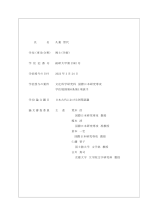4 0 0 0 IR 日本古代における空間認識
- 著者
- 久葉 智代 クバ トモヨ Tomoyo KUBA
- 出版者
- 総合研究大学院大学
- 巻号頁・発行日
- 2023
総研大甲第2382号
- 著者
- Yasuyuki Kano Yuta Hashimoto Ichiro Nakanishi Junzo Ohmura Tama Amano Tomoyo Kuba Haruno Sakai Kazuyuki Ito Yoko Odagi Makiko Nishikawa Haruo Horikawa Kazuya Mizushima Ryoichi Yasukuni Munehisa Yamamoto
- 出版者
- 日本地震学会学, 日本測地学会学長
- 雑誌
- IAG-IASPEI 2017
- 巻号頁・発行日
- 2017-07-11
We have launched Web-based transcription project “Minna de Honkoku" in January, 2017. The URL is https://honkoku.org/. “Minna de Honkoku" is also the name for Web application to realize this online transcription project. The study of historical earthquake is based on historical documents. In Japan, almost all of the documents are written in Kuzushi-ji. Kujzushi-ji is writing style used before ~1900. Since the style is different from that of modern Japanese, transcription is necessary to use the historical documents as data for earthquake research. Catalogs of historical records such as "New collection of materials for the history of Japanese earthquakes" has been published and used for earthquake research. Although huge number of historical documents survives, the majority of the documents left untranscribed. We loaded 114 historical documents included in the Ishimoto correction in Earthquake Research Institute Library, the University of Tokyo. We planned to start the transcription project with historical document describing past earthquakes on "Minna de Honkoku," although the application can be used for any type of historical document. "Minna de Honkoku" consists of viewer of document image and vertical (Japanese-style) editor for transcription. Users can input transcribed texts viewing its image. The ranking of words transcribed is displayed to keep motivation of users. The edit history and online bulletin board are implemented to enhance communication between users. The application is inked to Kuzushi-ji Learning Application, KuLA developed by Osaka University. Transcription has been completed for 29 documents out of total 114 documents in 3 weeks. Total number of inputted character is about 700,000. To finish the transcription of 114 earthquake-related historical document is the main goal of the project. In addition, the Web-based project may attract people who are not interested in local earthquake history and natural disaster.
1 0 0 0 IR 八世紀における境界認識 : 大和国を中心に
- 著者
- 久葉 智代 Tomoyo KUBA くば ともよ
- 出版者
- 総合研究大学院大学文化科学研究科 / 葉山町(神奈川県)
- 雑誌
- 総研大文化科学研究 = Sokendai review of cultural and social studies (ISSN:1883096X)
- 巻号頁・発行日
- no.16, pp.1-15, 2020-03
本論文では、八世紀における大和国周辺のどのような場所が境界とされていたのか、そしてその境界がどのように認識されていたのかを、自然と人工の両面から検討する。主に以下の二点に着目する。一つ目は、自然地形と交通路との関係である。『日本書紀』の改新詔にみられる畿内堺のように、古代における境界は山や川を一つの区切りとしている。その境界とは、現代のように明確な線を引いたものではなく、ある地点から見た各方角の一地点を代表させたものである。大和国に目を向けてみると、『万葉集』では、北・南・西の各方角において、奈良山・真土山・生駒山・龍田山というそれぞれの山が境界として認識されている。これは、いずれも平城京からの交通路上に位置する山である。東の境界のみはほとんど現れないが、平城京から東へ向かうには、直接東方の山を越えるのではなく、一旦南下する必要があり、交通路を基にした境界認識を持っていた当時の人々にとっては、東へ向かうという体感が乏しかったことがその一因であると考える。二つ目は、祭祀と境界との関係である。境界で行われる祭祀として、「手向け」がある。交通路の主要な地点(主に坂や峠)において安全を祈る行為であるが、前述した大和国周辺の山が手向けを行う場となっていることが『万葉集』からわかる。 また、都城や畿内の境界において行われる疫神祭祀について、「疫神が交通路を通じて入ってくる」という指摘は従来からなされている。加えて、『日本書紀』の記事の中で、大和国の周辺で祭祀を行ったとされる場が、交通路上で境界とされる山々と一致している。祭祀における境界も、交通路が基になっていることがわかる。ある地点を境界として認識するということは、単なる景物に境界性を与えるのではなく、自らが交通路を利用して移動する際の状況を投影したものであった。この時代の境界とは、現代のように俯瞰で正確な地形を捉え、明確な線を引くものではなく、曖昧な幅を持ったものであったといえる。そのような境界に囲まれた空間の把握についても、明確な領域の意識があったのではなく、自身の経験と認知によるものであったと推測される。This paper discusses the boundaries in Yamato from both artificial and natural perspectives. The following two points are discussed.First, the relationship between the natural terrain and traffic routes is discussed. In ancient Japan, mountains and rivers were considered to be boundaries, as in the case of the boundaries of Kinai referred to in Kaishin no mikotonori in Nihon-shoki. The boundaries, however, were not clearly indicated lines, but served as landmarks representing directions. In the case of Yamato, Mt. Nara, Mt. Matsuchi, Mt. Ikoma and Mt. Tatsuta were considered to be boundaries in the north, south and west respectively. All these mountains are located on the traffic route from Heijo-kyo. The boundary on the east side of Yamato is not clear because people had to go south before heading east. It might have been difficult for people performed boundary recognition based on the traffic route to have a sense of going east.Second, the relationship with rituals held at the boundary is discussed. One such ritual is Tamuke, a prayer safe travel at the major points on the road, for example, in the mountains. According to Man'yoshu, the mountains around Yamato are mentioned above were places for rituals.It has been pointed out that the rituals were conducted on the boundaries of the capital and Kinai, because Ekijin (gods that bring illness) were considered to enter through the traffic route. Furthermore, the places where the rituals were thought to have been conducted correspond to the mountains that were regarded as boundaries. It is obvious that boundaries used for rituals were the basis for the traffic routes.When a specific point was recognized as a boundary, it did not mean that the boundary was simply a natural feature, but provided certain situations when people travel on the traffic route. The boundaries in those times were of ambiguous width, unlike today's clear lines. It is assumed that the recognition of space was based on people's experience and perception.
